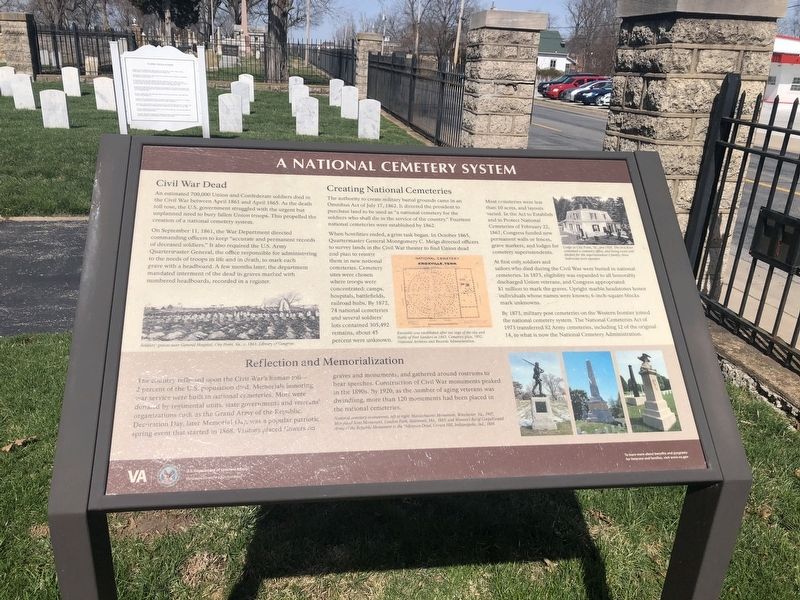Jefferson City in Cole County, Missouri — The American Midwest (Upper Plains)
A National Cemetery System
Civil War Dead
An estimated 700,000 Union and Confederate soldiers died in the Civil War between April 1861 and April 1865. As the death toll rose, the U.S. government struggled with the urgent but unplanned need to bury fallen Union troops. This propelled the creation of a national cemetery system.
On September 11, 1861, the War Department directed commanding officers to keep "accurate and permanent records of deceased soldiers.” It also required the U.S. Army Quartermaster General Montgomery C. Meigs directed officers to survey lands in the Civil War theater to find Union dead grave with a headboard. A few months later, the department mandated interment of the dead in graves marked with numbered headboards, recorded in a register.
Creating National Cemeteries
The authority to create military burial grounds came in an Omnibus Act of July 17, 1862.It directed the president to purchase land to be used as "a national cemetery for the soldiers who shall die in the service of the country.” Fourteen national cemeteries were established by 1862.
When hostilities ended, a grim task began, In October 1865, Quartermaster General Montgomery C. Meigs directed officers to survey lands in the Civil War theater to find Union dead and plan to reinter them in new national cemeteries. Cemetery sites were chosen-where troops were concentrated: camps, hospitals, battlefields, railroad hubs. By 1872, 74 national cemeteries and several soldiers' lots contained 305,492 remains, about 45 percent were unknown.
Most cemeteries were less than 10 acres, and layouts varied. In the Act to Establish and to Protect National Cemeteries of February 22, 1867, Congress funded new permanent walls or fences, grave markers, and lodges for cemetery superintendents.
At first only soldiers and sailors who died during the Civil War were buried in national cemeteries. In 1873, eligibility was expanded to all honorably discharged Union veterans, and Congress appropriated $1 million to mark the graves. Upright marble headstones honor individuals whose names were known; 6-inch-square mark unknowns.
By 1873, military post cemeteries on the Western frontier joined the national cemetery system. The National Cemeteries Act of 1973 transferred 82 Army cemeteries, including 12 of the original 14, to what is now the National Cemetery Administration.
Soldiers' graves near General Hospital, City Point, Va., ca. 1863. Library of Congress
Knoxville was established after the siege of the city and, Battle of Fort Sanders in 1863, Cemetery plan, 1892; National Archives and Records Administration.
Lodge at City Point, Va., pre-1928. The first floor contained a cemetery office, and living room and kitchen for the superintendent's family; three bedrooms were upstairs.
[Sidebar:]
Reflection and Memorialization
The country reflected upon the Civil War's human toll-2 percent of the U.S. population died. Memorials honoring war service were built in national cemeteries. Most were donated by regimental units, state governments and veterans' organizations such as the Grand Army of the Republic. Decoration Day, later Memorial Day, was a popular patriotic spring event that started in 1868. Visitors placed flowers on graves and monuments, and gathered around rostrums to hear speeches. Construction of Civil War monuments peaked in the 1890s. By 1920, as the number of aging veterans was dwindling, more than 120 monuments had been placed in the national cemeteries.
National cemetery monuments, left to right: Massachusetts Monument, Winchester, Va, 1907, Maryland Sons Monument, Loudon Park, Baltimore, Md, 1885; and Women's Relief Corps/Grand Army of he Republic Monument to the Unknown Dead, Crown Hill, Indianapolis, Ind., 1889.
Erected by U.S. Department of Veterans Affairs, National Cemetery Administration.
Topics and series. This historical marker is listed in these topic lists: Cemeteries & Burial Sites • War, US Civil. In addition, it is included in the National Cemeteries series list. A significant historical date for this entry is February 22, 1867.
Location. 38° 34.004′ N, 92° 9.69′ W. Marker is in Jefferson City, Missouri, in Cole County. Marker is on East McCarty Street just west of Locust Street, on the left when traveling west. Touch for map. Marker is at or near this postal address: 1024 E McCarty St, Jefferson City MO 65101, United States of America. Touch for directions.
Other nearby markers. At least 8 other markers are within walking distance of this marker. Jefferson City National Cemetery (here, next to this marker); Navy Seabees (within shouting distance of this marker); Woodland-Old City Cemetery (within shouting distance of this marker); 39th Regiment Monument (within shouting distance of this marker); State Lot (within shouting distance of this marker); a different marker also named State Lot (within shouting distance of this marker); Veterans Memorial (about 300 feet away, measured in a direct line); Missouri State Penitentiary Warden's House (approx. 0.4 miles away). Touch for a list and map of all markers in Jefferson City.
Credits. This page was last revised on November 8, 2021. It was originally submitted on November 8, 2021, by Devry Becker Jones of Washington, District of Columbia. This page has been viewed 105 times since then and 16 times this year. Photo 1. submitted on March 25, 2021, by Devry Becker Jones of Washington, District of Columbia.
Editor’s want-list for this marker. A wide shot of the marker in context. • Can you help?
